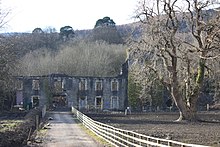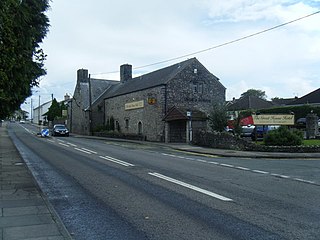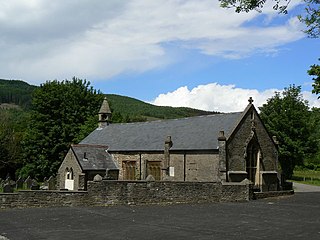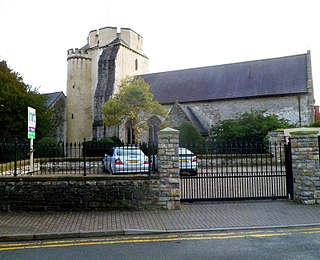

Aberpergwm House (Welsh : Aberpergwm) is an abandoned and ruinous country house located in Glynneath, Wales. Within the grounds of the house sits the church of St. Cadoc, which is possibly of late medieval origin. [1]


Aberpergwm House (Welsh : Aberpergwm) is an abandoned and ruinous country house located in Glynneath, Wales. Within the grounds of the house sits the church of St. Cadoc, which is possibly of late medieval origin. [1]
The present house is a remodelling of an older house known as Neuadd Pergwm. [2] The house came into the ownership of the Williamses of Blaen Baglan in around 1560. [2] It is said that Oliver Cromwell was related, and so the house was saved from pillage during the English Civil War. [2] The Williams family were one of the few Welsh gentry families to remain faithful to the Welsh language. [3] The family's London residence was at Stratford Place. [4]

By 1850, the house was ‘playfully crenellated’ with a central pediment” [2] In 1876, the house was remodelled by Morgan Stuart Williams, [2] who later went on to restore St Donat's Castle [1] This ‘overwhelmed’ the work of 1850, and included the addition of a new front range dominated by a ‘remarkable top heavy Elizabethan gallery across the whole front’ of 94 feet. [2] The gallery was added in the spirit of the ancient Glamorgan halls, such as Llantrithyd Place. [2] A further castellated wing was added along the hill. [2] In 1868, Williams had rejected earlier plans by John Norton for a new house in Gothic style with a tower. [2] Williams, by rejecting Norton’s Victorian High Gothic appeared to be playing safe. [1] An elaborate central door surround (now missing) could be a 17th-century Jacobean survival, or may be a convincing replica. [1] The house is built of Pennant Sandstone with Bath stone dressings. [2]

The East Anglian School for Deaf and Blind Children at Gorleston-on-Sea in Norfolk was evacuated to the house in the summer of 1940 because of its vulnerable position on the east coast of England during the Second World War. For the rest of the war the school was based in Aberpergwm House. [5] [6]
After the war the house was leased to the National Coal Board and used as offices; the surrounding park land was mined for coal. [2] At some time the house finally suffered a disastrous fire, and was not rebuilt. The 1876 gallery on the third storey has since collapsed leaving a seven-bay front of two storeys, with a small part surviving of the third. [1] Some of the medieval tracery from the original house has since been reincorporated into Penhow Castle. [2] The house is still owned by the Williams Family.[ citation needed ] Part of the Williams family remained in Wales until 2015 living in Llanharan House. [7]

In the fifteenth century, Aberpergwm House was the home of Rhys ap Siancyn and his descendants, the most prominent of the poets’ patrons in Glamorgan during the period. [3] Dafydd Nicolas, a Williams family descendant, was among the last of the Welsh household bards and the folksong collector Maria Jane Williams was a member of the family. [3] Her older brother, Rees Williams, was involved in establishing the Bank of Williams and Rowland. The Williams family motto: 'A ddioddefws a orfu' ('He who suffers triumphs', in English) became the motto of Glamorgan County Council. [3] The Liberal Party MP Sir Rhys Rhys-Williams was a member of the family, as was Conservative Party MP and MEP Sir Brandon Rhys-Williams. [8]
The house is listed Grade II by Cadw and is undergoing extensive building work[ citation needed ] to conserve its important historical contents and structure. [9] [10] The ornate wrought iron gates in the driveway are separately listed as Grade II, [11] and the church, which is being restored, is Grade II* listed. [12]

Gorleston-on-Sea, historically and colloquially known as Gorleston, is a seaside town in the borough of Great Yarmouth in Norfolk, England. It lies to the south of Great Yarmouth, on the opposite side of the mouth of the River Yare. Historically in Suffolk, it was a port town at the time of the Domesday Book. It was incorporated into Great Yarmouth in 1836. Gorleston's port became a centre of fishing for herring along with salt pans used for the production of salt to preserve the fish. In Edwardian times the fishing industry rapidly declined and the town's role changed to that of a seaside resort.

Llantwit Major is a town and community in Wales on the Bristol Channel coast. It is one of four towns in the Vale of Glamorgan, with the third largest population after Barry and Penarth, and ahead of Cowbridge. It is 4+1⁄2 miles (7.2 km) from Cowbridge, 9 miles (14 km) from Bridgend, 10 miles (16 km) from Barry, and 15 miles (24 km) from Cardiff. It had a population of 9,530 in 2021.

Glynneath, also spelt Glyn-neath and Glyn Neath, is a small town, community and electoral ward lying on the River Neath in the county borough of Neath Port Talbot, Wales. It was formerly in the historic county of Glamorgan. Glynneath ward covers only part of the community, with some 840 electors included in the neighbouring ward of Blaengwrach.

Edward Williams, better known by his bardic name Iolo Morganwg, was a Welsh antiquarian, poet and collector. He was seen as an expert collector of Medieval Welsh literature, but it emerged after his death that he had forged several manuscripts, notably some of the Third Series of Welsh Triads. Even so, he had a lasting impact on Welsh culture, notably in founding the secret society known as the Gorsedd, through which Iolo Morganwg successfully co-opted the 18th-century Eisteddfod revival. The philosophy he spread in his forgeries has had an enormous impact upon neo-Druidism. His bardic name is Welsh for "Iolo of Glamorgan".

St Donat's Castle, St Donats, Wales, is a medieval castle in the Vale of Glamorgan, about 16 miles (26 km) to the west of Cardiff, and about 1+1⁄2 miles (2.4 km) to the west of Llantwit Major. Positioned on cliffs overlooking the Bristol Channel, the site has been occupied since the Iron Age, and was by tradition the home of the Celtic chieftain Caradog. The present castle's origins date from the 12th century when the de Haweys and later Peter de Stradling began its development. The Stradlings held the castle for four hundred years, until the death of Sir Thomas Stradling in a duel in 1738.

Saint Cadoc or Cadog was a 5th–6th-century Abbot of Llancarfan, near Cowbridge in Glamorgan, Wales, a monastery famous from the era of the British church as a centre of learning, where Illtud spent the first period of his religious life under Cadoc's tutelage. Cadoc is credited with the establishment of many churches in Cornwall, Brittany, Dyfed and Scotland. He is known as Cattwg Ddoeth, "the Wise", and a large collection of his maxims and moral sayings were included in Volume III of the Myvyrian Archaiology. He is listed in the 2004 edition of the Roman Martyrology under 21 September. His Norman-era "Life" is a hagiography of importance to the case for the historicity of Arthur as one of seven saints' lives that mention Arthur independently of Geoffrey of Monmouth's Historia Regum Britanniae.

Rhigos is a small village on the saddle of higher ground between the Vale of Neath and the Cynon Valley. It was part of the old Neath Rural district Council under Glamorgan until 1974. The village then came under the jurisdiction of The Cynon Valley Borough which subsequently became Rhondda Cynon Taf, South Wales in 1996. It lies just off the old Aberdare road that was the main link between Aberdare and Glynneath, before the A465 road was extended in the 1960s. The hamlets of Cefn Rhigos and Cwm-Hwnt lie to the west of the main village.

Llanvaches or Llanfaches is a village and community parish within the boundaries of the city of Newport, Wales. It lies to the east of the urban area, in the historic county of Monmouthshire and the preserved county of Gwent. The population rose to 402 by the 2011 census.

Dyffryn Gardens, also spelt Duffryn Gardens, is a collection of botanical gardens located near the villages of Dyffryn and St. Nicholas in the Vale of Glamorgan, Wales. The gardens were selected by the British Tourist Authority as one of the Top 100 gardens in the UK and are in the care of the National Trust. They are designated at Grade I, the highest grade, on the Cadw/ICOMOS Register of Parks and Gardens of Special Historic Interest in Wales.

Pendoylan is a rural village and community (parish) in the Vale of Glamorgan, Wales. The village has won many awards in Best Kept Village competitions and contains 27 entries in the Council's County Treasures database, 13 of which are listed buildings.

Edwin Seward (1853–1924) was an architect based in Cardiff, Wales.
Aberpergwm is the site of a colliery in the Vale of Neath near Glynneath in south Wales.

Maria Jane Williams was a 19th-century Welsh musician and folklorist born at Aberpergwm House, Glynneath in Glamorgan, South Wales. She rescued many Welsh songs from obscurity, including Y Deryn Pur and Y Ferch o'r Sger.
The Bank of Williams and Rowland was a bank established in the 19th century and operating in Neath, in south Wales.

Llanharan House is a historic house on the outskirts of Llanharan, Rhondda Cynon Taf, Wales. It is located off the A473 road, just east of Llanharan and is a Grade II* listed building. The gardens and park attached to the house are designated Grade II on the Cadw/ICOMOS Register of Parks and Gardens of Special Historic Interest in Wales.

Laleston is a village and a community in Bridgend County Borough, south Wales, directly west of Bridgend town centre. The village takes its name from the Norman Lageles family who settled in the area. Buildings of note in the village include St David's Church, which still possesses features dating back to the 13th and 14th centuries, the Great House which was built in the early 16th century and Horeb Welsh Presbyterian Church (1831).

Welsh St Donats is a village and a community in the Vale of Glamorgan, Wales. Consisting of 1207 hectares of mainly rural land, it is located north east of Cowbridge. The population of the community was 534 in the 2011 census. Welsh St Donats includes the villages of Maendy, Prisk and Tair Onen. A mile to the east from the village lies the Hensol Forest, while the remains of Talyfan Castle are to the north.

St. Cadoc's Church is a Church in Wales church in Glynneath, Wales. It is located in the grounds of the now derelict Aberpergwm House for which it was an estate church.

The Church of the Holy Cross is a medieval church in Cowbridge in the Vale of Glamorgan, south Wales. Initially a chapel of ease to Church of St John the Baptist, Llanblethian of Cowbridge as a medieval market town. Believed to have been built in the 13th century, the church has an unusual tower design. It has undergone several restorations including one by John Prichard in 1850–52. The Church of the Holy Cross was listed as a Grade I building on 12 May 1963.
Dafydd Nicolas, or David Nicholas was a Welsh poet.